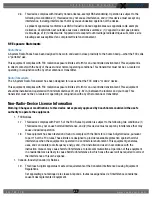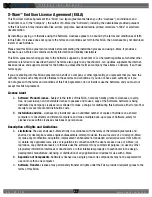
O P E R A T I N G M A N U A L
8 0 0 . 7 4 9 . 2 7 6 1
w w w . c o a c h c o m m . c o m
7 2
Lithium-Polymer Battery Maintenance
Storage of your Lithium-Polymer Batteries
When stored, a battery gradually loses its overall charge time due to internal self-discharge, which may reduce its overall
power. If storing batteries for two or more weeks, CoachComm highly recommends storing them at a 40–50% charge level,
which generally minimizes any permanent power capacity loss.
Unused lithium-polymer batteries may enter into a deep discharge state due to internal self-discharge. Once a battery has
gone into deep discharge, its onboard circuit protections inhibit the charger from initiating the charge cycle. If a battery
does not accept a charge and the LED displays red in the charger, the battery may be in deep discharge. An attempt
to revive the battery can be made by repeatedly inserting and removing it several times from the 5-bay charger (CBT-
5BAY-01).
Ambient temperature affects the rate at which lithium-polymer batteries degrade. Batteries also degrade and lose overall
power capacity if stored (or used) at higher temperatures.
Proper Disposal of Old Lithium-Polymer Batteries
Batteries that appear swollen, deformed, or damaged, or that do not fit properly should never be used. Properly dispose of
any batteries in this condition in accordance with the instructions provided by your local authorities. For more information
and local drop-off sites, visit
Battery Shipping Regulations
Rechargeable lithium-polymer batteries are subject to special U.S. and International regulations, particularly regarding
transportation. The guidelines detailed in CoachComm’s
Lithium-Polymer Battery Shipping Guidelines
with updated International Air Transport Association (IATA), International Civil Aviation Organization (ICAO), and U.S.
Department of Transportation (DOT) Dangerous and Hazardous Goods regulations.
When shipping equipment to CoachComm that includes batteries, it is the shipper’s responsibility to ensure that batteries
are properly packaged, labeled, and shipped according to local and international guidelines. “Shipper” is defined as the
person or school placing the equipment in the package and offering it to the carrier.






























